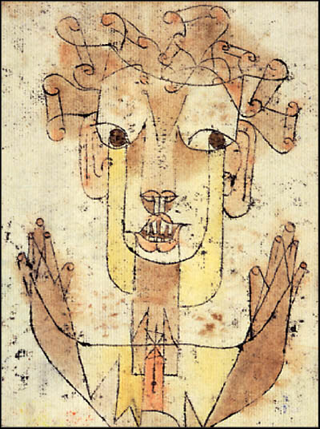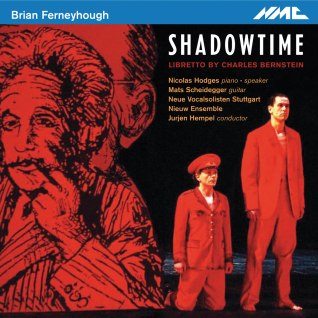 Angelus Novus – an angel who seems about to move away from something he stares at. His eyes are wide, his mouth is open, his wings are spread. This is how the angel of history must look. His face is turned toward the past. Where a chain of events appears before us, he sees one single catastrophe, which keeps piling wreckage upon wreckage and hurls it at his feet. The angel would like to stay, awaken the dead, and make whole what has been smashed. But a storm is blowing from Paradise and has got caught in his wings; it is so strong that the angel can no longer close them. This storm drives him irresistibly into the future to which his back is turned, while the pile of debris before him grows toward the sky. What we call progress is this storm. – The ninth thesis from Walter Benjamin’s 1940 work, “On the Concept of History.”
Angelus Novus – an angel who seems about to move away from something he stares at. His eyes are wide, his mouth is open, his wings are spread. This is how the angel of history must look. His face is turned toward the past. Where a chain of events appears before us, he sees one single catastrophe, which keeps piling wreckage upon wreckage and hurls it at his feet. The angel would like to stay, awaken the dead, and make whole what has been smashed. But a storm is blowing from Paradise and has got caught in his wings; it is so strong that the angel can no longer close them. This storm drives him irresistibly into the future to which his back is turned, while the pile of debris before him grows toward the sky. What we call progress is this storm. – The ninth thesis from Walter Benjamin’s 1940 work, “On the Concept of History.”
(See my full blog post, below.)
Category: Ruminations
France: Rock bottom
Lonely figure: François Hollande, with approval ratings of 20%, is the most unpopular president in French postwar history.
A desolate image broadcast live this week to a French public that has all but despaired of his presidency summed up the plight of François Hollande.
Flown by helicopter to the windswept island of Sein off the rocky west coast of Brittany for a ceremony to commemorate the liberation of France from Nazi occupation 70 years ago, Mr Hollande stood to give his speech unprotected from a lashing Atlantic rainstorm.
No presidential huissier, no aide-de-camp, not even an alert public relations official stepped forward with an umbrella. Instead, the most unpopular president in French postwar history was left alone and bedraggled against a bleak island backdrop, the rain obscuring his spectacles, soaking his hair and running down his neck.
“Avec moi, le déluge,” joked the satirical newspaper Canard Enchaîné on its front page…..
The rest of the article is a lamentation of the state French culture, economics, and apparent lack of Joie de vivre and may be found at: http://www.ft.com/cms/s/0/03b35434-2f5b-11e4-a79c-00144feabdc0.html
This article lead me to digging for information about Île-de-Sein, which turned up Mário Gonçalves’ Quest for Tule blog on remote islands. His July 2010 post is about Île-de-Sein and I have taken the liberty of reproducing it here together with a comment on the origin of “Thule” and an additional picture at the end. – wej
Thule (Greek: Θούλη, Thoúlē – Pytheas, 320 BC) also spelled Thula,Thila, or Thyïlea, is, in classical European literature and maps, a region in the far north. Though often considered to be an island in antiquity, modern interpretations of what was meant by Thule often identify it as Norway, an identification supported by modern calculations. Other interpretations include Orkney, Shetland, andScandinavia. In the Late Middle Ages and Renaissance, Thule was often identified as Iceland or Greenland. Another suggested location is Saaremaa in the Baltic Sea.The term ultima Thulein medieval geographies denotes any distant place located beyond the “borders of the known world”. Sometimes it is used as a proper noun (Ultima Thule) as the Latin name for Greenland whenThule is used for Iceland. – Wikipedia
Sein island (Île-de-Sein)
Brittany, France
Now this Ultima Thule in France´s Finistère may not be so remote and northernly as others I have reported here, but it is surely magic in its wilderness, situation and life style. Getting there is not a hard adventure, but living there is.

This piece of rock is certainly the strangest island off the coast of Brittany, one of the six Celtic nations.
Île-de-Sein is a french islet in the Atlantic Ocean, 10 km off the extreme northwest of Finistère, 2 km long for at most a few hundred metres wide. Nowhere does it rise more than six metres above the surrounding ocean.
Lying on the sea routes going south from the English Channel, Sein is well known for the dangers of its waters. The Chaussée de Sein, a vast zone of reefs, stretches for more than thirty miles from east to west, requiring numerous lighthouses, to prevent increasing the large numbers of shipwrecks in the past.

The Island of Sein has been inhabited since prehistoric times, and it was reputed to have been the very last refuge of the druids in Brittany . Some menhirs can be found there.

Three hundred islanders continue to make their living from the sea, gathering rainwater and seaweed and fishing for scallops, lobster and crayfish.
The village
In order to be protected from the sea and storms, the village has very narrow streets, a real labyrinth. The streets twist and turn against the wind, and in most places are built only wide enough to roll a barrel. Only bicycles are allowed.


Details of sea life decorate most houses, in the dominating blue colour.

On the blackboard – “croissants available by command for Christmas and New Year’s Eve”. That shows how isolated the island is from mainland.
Phare de la Vieille
One of the most famous French lighthouses, this tower is built on a rock that half way from mainland to Île-de-Sein. In big sea storms, waves crash against the lighthouse and seem to swallow it – but La Vieille always keeps working.
Heavy seas.
http://ultima0thule.blogspot.com/2010/07/sein-island-ile-de-sein-brittany-france.html
2 comments:
-
Stéphane Bidouze said…
- Hey, it’s not the phare de la vieille, but the four lighthouse, phare du four, it is also in brittany, but north from the la vieille!
regards
STéphane -
Mário said…
Merci bien, Stéphane, j’ai déja fait la correction, cette nouvelle image est aussi impressionante que l’antérieure.
Mario
18 October 2012 21:15
Down a rabbit hole
`Come back!’ the Caterpillar called after her. `I’ve something important to say!’
“The Caterpillar and Alice looked at each other for some time in silence: at last the Caterpillar took the hookah out of its mouth, and addressed her in a languid, sleepy voice.
‘Who are you?’ said the Caterpillar.
This was not an encouraging opening for a conversation. Alice replied, rather shyly, ‘I — I hardly know, sir, just at present — at least I know who I was when I got up this morning, but I think I must have been changed several times since then.’
‘What do you mean by that?’ said the Caterpillar sternly. ‘Explain yourself!’
‘I can’t explain myself, I’m afraid, sir’ said Alice, ‘because I’m not myself, you see.’
‘I don’t see,’ said the Caterpillar.
‘I’m afraid I can’t put it more clearly,’ Alice replied very politely, ‘for I can’t understand it myself to begin with; and being so many different sizes in a day is very confusing.’
Chapter V
Advice from a Caterpillar

from: http://www.lockportstreetgallery.com/AliceinWonderland.htm
Walter Benjamin and Klee’s Angelus Novus

My wing is poised to beatbut I would gladly return homewere I to stay to the end of daysI would still be this forlorn— Gershom Scholem, “Greetings from Angelus” [tr. Richard Sieburth]
The world’s most terrifying letter
Letter from Herman Göring to Reinhard Heydrich that lead to Heydrich chairing the 1942 Wannsee Conference, which discussed plans for the deportation and extermination of all Jews in German-occupied territory. Though the chain of command went from Heinrich Himmler to Heydrick, Göring was appointed Reichsmarschall by Hitler in 1941 making him senior to all other military commanders.













